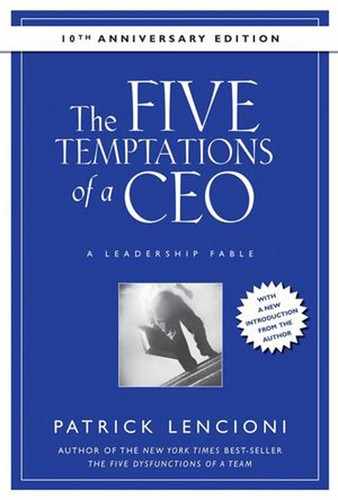INTRODUCTION
Being the chief executive of an organization is one of the most difficult challenges a person can face in a career. But it is not a complicated one.
Some CEOs, especially the struggling ones, might disagree with this statement. They’ll tell you their jobs are riddled with complexities and subtleties that make success impossible to predict. If their organizations fail, they may point to a tired list of causes like strategic errors, marketing inadequacies, competitive threats, and technology failures. But these are only symptoms of their troubles.
All chief executives who fail—and most of them do at one time or another—make the same basic mistakes; they succumb to one (or more!) of the five temptations.
If this is true, if a CEO’s success hinges on just a few behaviors, then why don’t more of them succeed? Why do they keep looking at the same financial statements, product development schedules, and marketing reports in search of a silver bullet? I think Lucille Ball answers this question best.
In an old episode of the I Love Lucy show, Ricky comes home to find Lucy crawling around the living room on all fours. When he asks her what she’s doing she explains that she has lost her earrings. “You lost your earrings in the living room?” Ricky asks. Lucy replies, “No, I lost them in the bedroom—but the light is so much better out here.”
For many CEOs the light is best in places like marketing, strategic planning, and finance, safe havens from the painful darkness of behavioral self-examination. Unfortunately, they find little opportunity for meaningful improvement in these areas.
Even relatively progressive executives often stay in the comfort of their “living rooms,” sampling management fads and leadership trends in search of relatively painless remedies for their ills. While some of those remedies appear to work for a while, they eventually leave executives exposed to the same basic issues that caused their problems in the first place, the ones explored in this book.
The tragedy here is that most executives are intuitive enough to understand all this—but many of them struggle to do anything about it. Instead, they unconsciously distract themselves and others from their personal leadership issues by getting overly involved in the details of their businesses, often to the point of creating complexity where it shouldn’t exist.
Essentially, what they are doing is putting the success of their organizations in jeopardy because they are unwilling to face—and overcome—the five temptations of a CEO.
..................Content has been hidden....................
You can't read the all page of ebook, please click here login for view all page.
